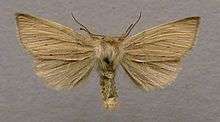Sedina buettneri
Sedina buettneri, or Blair's wainscot, is a moth of the family Noctuidae. The species was first described by Eduard von Hering in 1858. It is found in the Palaearctic ecozone. Outside of Europe, it is occasionally found in temperate Asia, the coast of the Black Sea, the base of the Caucasus mountains, the Caspian Sea, Iran, Russia and further east to the Ural, the Lake Baikal and Altai region in Japan and the Kuril Islands.
| Sedina buettneri | |
|---|---|
 | |
| Scientific classification | |
| Kingdom: | |
| Phylum: | |
| Class: | |
| Order: | |
| Family: | |
| Tribe: | |
| Genus: | |
| Species: | S. buettneri |
| Binomial name | |
| Sedina buettneri (Hering, 1858) | |
| Synonyms | |
| |
Technical description and variation
Forewing straw-colour, the veins rufous, the intervals with grey streaks; hindwing grey, with rufous veins. [1]The wingspan is 20–35 mm.
Biology
The moth flies from August to October in one generation depending on the location.
The larvae feed on Carex acutiformis and Glyceria species.
References
- Warren. W. in Seitz, A. Ed., 1914 Die Großschmetterlinge der Erde, Verlag Alfred Kernen, Stuttgart Band 3: Abt. 1, Die Großschmetterlinge des palaearktischen Faunengebietes, Die palaearktischen eulenartigen Nachtfalter, 1914

External links
| Wikimedia Commons has media related to Sedina buettneri. |
- Kimber, Ian. "73.135 BF2376 Blair's Wainscot Sedina buettneri (Hering, 1858)". UKMoths. Retrieved 5 July 2019.
- Fauna Europaea
- Lepiforum e.V.
- Schmetterlinge-Deutschlands.de
This article is issued from Wikipedia. The text is licensed under Creative Commons - Attribution - Sharealike. Additional terms may apply for the media files.